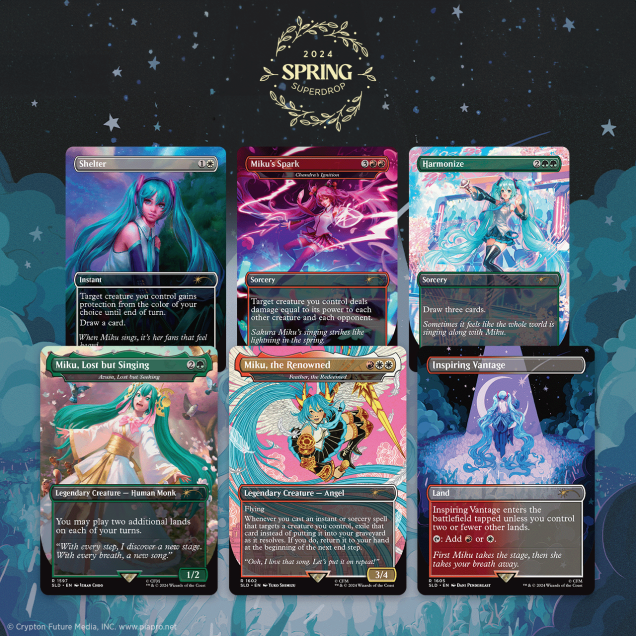Creating music with Hatsune Miku’s Voicebank is easier than you think. It offers a unique way to produce songs with a digital voice.
In this guide, you will learn how to use this popular software to make your own music. Hatsune Miku, a virtual singer, has captured the hearts of many music fans worldwide. Her Voicebank lets anyone create professional-sounding tracks. Whether you are a beginner or an experienced musician, this tool can help you bring your musical ideas to life.
By following some simple steps, you can start composing your own songs using her voice. This introduction will provide you with the basic knowledge you need to get started. Let's dive into the world of digital music creation with Hatsune Miku's Voicebank.
Introduction To Hatsune Miku
Discover the process of creating music with Hatsune Miku’s voicebank. Learn how to craft melodies using her unique vocal tones. Start your musical journey today.
Hatsune Miku is a popular virtual singer. Created by Crypton Future Media, she uses a voicebank from Vocaloid software. She has gained immense popularity worldwide. Many music producers use her voice to create unique songs.Who Is Hatsune Miku?
Hatsune Miku is a virtual pop star. She is represented by a 16-year-old girl with long turquoise hair. Her voice is generated by Yamaha's Vocaloid software. She was first released in 2007. Miku's voice is sampled from voice actress Saki Fujita.Popularity And Impact
Hatsune Miku has a massive fanbase. She has performed live concerts as a hologram. Fans across the globe adore her. Many producers have created music using her voicebank. She has appeared in various media, including video games and commercials. Her influence in the music industry is significant. She has opened doors for virtual artists worldwide. “`
Credit: www.youtube.com
Getting Started
Creating music with Hatsune Miku's voicebank can be exciting and rewarding. This guide will help you get started with the required software and hardware, and set up your workspace for a smooth music creation process.
Required Software And Hardware
To begin, you need specific software and hardware. Here are the essentials:
- Vocaloid Editor: This is the primary software to manipulate Miku's voice.
- Digital Audio Workstation (DAW): Software like FL Studio or Ableton Live is crucial for composing and mixing.
- Hatsune Miku Voicebank: A licensed copy of Miku's voicebank is necessary.
Aside from the software, you need some basic hardware:
- Computer: A computer with decent specifications to run the software smoothly.
- MIDI Keyboard: This helps in composing melodies and harmonies.
- Headphones or Studio Monitors: Essential for high-quality sound monitoring.
Setting Up Your Workspace
Having a well-organized workspace boosts creativity and productivity. Follow these tips to set up your music production area:
- Choose a Quiet Room: Find a room with minimal noise and distractions.
- Ergonomic Setup: Ensure your chair and desk are comfortable. This helps during long hours of work.
- Proper Lighting: Adequate lighting reduces eye strain and keeps you focused.
- Arrange Equipment: Keep your computer, MIDI keyboard, and headphones within easy reach.
With the right software, hardware, and workspace setup, you're ready to create amazing music with Hatsune Miku's voicebank.
Installing Hatsune Miku’s Voicebank
Installing Hatsune Miku’s Voicebank is an exciting step. It brings her voice to your music projects. This section will guide you through the installation. You will learn how to download and install the voicebank.
Downloading The Voicebank
First, visit the official Crypton Future Media website. Look for the Hatsune Miku voicebank. Click the download link. Save the file to your computer. Make sure you have enough space on your hard drive.
Installation Process
Locate the downloaded file on your computer. Right-click and select “Extract All.” Open the extracted folder. Look for the setup file. It may be named “setup.exe” or similar. Double-click the setup file. Follow the on-screen instructions. Choose the installation directory. Wait for the installation to complete. Once done, launch your Vocaloid software. You should see Hatsune Miku's voicebank available.
Now, you can start creating music with Hatsune Miku. Enjoy bringing your melodies to life with her unique voice.
Understanding Vocaloid Software
Creating music using Hatsune Miku’s Voicebank can be exciting. The Vocaloid software helps you make realistic vocal tracks. Understanding this software is crucial. It can be the difference between a good song and a great one. Let's dive into its key components.
Interface Overview
The Vocaloid software interface is user-friendly. It has several parts. The main parts include the piano roll, the control panel, and the toolbar.
- Piano Roll: This is where you input the notes. It looks like a grid. The vertical axis represents pitch. The horizontal axis represents time.
- Control Panel: Here, you can adjust various settings. These include volume, pitch, and vibrato.
- Toolbar: The toolbar contains tools for editing. You can select, draw, and erase notes.
Understanding the interface is the first step. It helps you navigate the software easily. Once you know your way around, you can start creating music.
Basic Functions
The basic functions of the Vocaloid software are easy to learn. These functions include note input, parameter control, and exporting your track.
- Note Input: Click on the piano roll to add notes. You can drag to change the length. Double-click to edit the lyrics.
- Parameter Control: Use the control panel to fine-tune your track. Adjust the pitch, volume, and other parameters. This makes the voice sound more natural.
- Exporting: Once your track is ready, export it. Go to the file menu and select ‘Export'. Choose your desired format.
Learning these basic functions is essential. They form the foundation of your music creation process. With practice, you'll get better at using them.
| Function | Description |
|---|---|
| Note Input | Add and edit notes on the piano roll |
| Parameter Control | Adjust pitch, volume, and other settings |
| Exporting | Save your track in a desired format |
Understanding these basic functions can improve your workflow. It can also enhance the quality of your music. Happy creating!
Creating Your First Track
Creating your first track using Hatsune Miku’s Voicebank can be an exciting journey. With some basic knowledge, you can start making music that resonates with listeners. Let’s break down the process into simple steps. First, we will choose a melody, and then we will input lyrics.
Choosing A Melody
The melody is the heart of your track. Start by selecting a genre. Decide if you want a fast or slow tempo. This will guide your melody creation. Use software like Vocaloid to help create a catchy tune.
- Open your music software.
- Select a virtual instrument.
- Create a simple melody using the piano roll.
- Experiment with different notes and rhythms.
Keep your melody simple at first. Focus on making it memorable.
Inputting Lyrics
Once you have a melody, it’s time to add lyrics. Think about the message you want to convey. Write short, clear lines that fit the melody. Use Vocaloid software to input the lyrics.
- Open the Vocaloid editor.
- Import your melody.
- Select Hatsune Miku’s voicebank.
- Input your lyrics line by line.
Adjust the pitch and timing to match the melody. Play back the track and make changes as needed. This will help you create a seamless integration of melody and lyrics.
Creating music with Hatsune Miku’s Voicebank can be simple and fun. Follow these steps to start your journey into music production.

Credit: www.topmediai.com
Fine-tuning Your Music
Fine-tuning your music with Hatsune Miku's voicebank can be a rewarding process. It allows you to add personal touches to your tracks. This section will guide you through essential adjustments to make your music stand out.
Adjusting Pitch And Tone
Pitch and tone play a crucial role in music creation. By adjusting these, you can make Miku's voice sound more natural. Use your software's pitch control to fine-tune each note. This helps to avoid robotic-sounding vocals.
Experiment with different pitches to find the best fit. Don't be afraid to try higher or lower tones. The goal is to match the voice with your music's mood.
Adding Dynamics And Expression
Dynamics and expression bring life to your music. They make Miku's voice more emotive. Use volume controls to add dynamics. Increase volume for emphasis and reduce it for softer parts.
Expression tools can add vibrato, breathiness, and other nuances. These details make the voice more human-like. Spend time experimenting with different settings. Your effort will make a big difference.
Mixing And Mastering
Mixing and mastering are crucial steps in creating music with Hatsune Miku’s voicebank. These processes ensure your track sounds polished and professional. Mixing involves balancing the elements of your song. Mastering is about giving the final touches to your track. Both are essential for a high-quality finished product.
Balancing Vocals And Instrumentals
Start by adjusting the levels of the vocals and instrumentals. Ensure Miku's voice stands out but does not overpower the music. Use EQ to carve out space for her vocals. This helps each element of the track to be heard clearly.
Panning can also help balance. Place different instruments in different parts of the stereo field. This creates a more dynamic and engaging mix. Pay attention to how Miku's voice interacts with the other elements.
Final Touches
After balancing, add reverb and delay to Miku's voice. This gives it a sense of space and depth. Use these effects sparingly to avoid muddying the mix. Compression can also help keep her voice consistent in volume.
Lastly, listen to the track on different devices. Ensure it sounds good on speakers, headphones, and even phone speakers. Make small adjustments as needed. This ensures your track sounds great no matter how it's played.
Exporting And Sharing
Easily export and share your music created using Hatsune Miku's voicebank. Share your tracks with friends and fans online.
Creating music with Hatsune Miku’s voicebank is a thrilling experience. Once you’ve crafted your track, it’s time to share your masterpiece with the world. This section will guide you through the crucial steps of exporting your track and sharing it on various platforms.Exporting Your Track
Before sharing, you need to export your track. Start by ensuring your project is complete and all elements are in place. Open your music software and locate the export function. Select the format for your export. Common formats include WAV and MP3. WAV files offer higher quality but take up more space. MP3 files are smaller and easier to share. Ensure you choose the right export settings. Check the bitrate and sample rate. Higher values give better sound quality. Name your file clearly. Save it in a location you can easily find. Once you hit export, wait for the process to complete. Your track is now ready for sharing.Sharing On Platforms
Sharing your track is the next exciting step. Choose platforms where your audience spends time. Popular options include SoundCloud, YouTube, and Bandcamp. Each platform has its own process for uploading music. On SoundCloud, log in and click the upload button. Select your exported file and fill in the details. Add a title, description, and tags. Tags help users find your music. YouTube requires a video format. Pair your track with a simple image or a lyric video. Use video editing software to combine them. Upload the final video to your YouTube channel. Bandcamp focuses on music discovery. Create an account and set up your artist profile. Upload your track and set a price or offer it for free. Share the link on social media to reach a wider audience.Tips And Tricks
Creating music with Hatsune Miku’s voicebank can be thrilling. Yet, mastering it requires some handy tips and tricks. This section offers insights to enhance your music production skills. Learn to avoid common mistakes and explore advanced techniques.
Common Mistakes To Avoid
Many beginners make similar errors. Ensure you use the correct voicebank version. Each version has unique features. Mixing versions can result in poor sound quality.
Avoid overloading the track with effects. Miku's voice needs clarity to shine. Excessive reverb and delay can muddy the sound. Stick to basic effects first.
Another mistake is ignoring pitch and timing. Miku's voice must match the melody. Use software tools to adjust pitch and timing accurately.
Advanced Techniques
Once you master the basics, try advanced techniques. Layering is a powerful method. Combine different voicebanks for a richer sound. Experiment with harmonies and backing vocals.
Use automation for dynamic expression. Adjust volume, pitch, and effects throughout the track. This creates a more lively performance.
Explore phoneme adjustments. Fine-tuning phonemes can improve pronunciation. This makes Miku’s voice sound more natural.
Lastly, integrate vocaloid plugins. These plugins offer unique features. They can enhance Miku's voice and expand your creative options.

Credit: lyricassistant.com
Frequently Asked Questions
What Is Hatsune Miku’s Voicebank?
Hatsune Miku's voicebank is a collection of vocal samples. It allows users to synthesize singing. It is used in various music production software.
How Can I Start Using Hatsune Miku’s Voicebank?
To start using Hatsune Miku's voicebank, install a compatible vocal synthesis software. Then, import the voicebank and follow the setup instructions.
What Software Works With Hatsune Miku’s Voicebank?
Hatsune Miku's voicebank works with Vocaloid and Piapro Studio. These programs allow users to create music using her voice.
Is Hatsune Miku’s Voicebank Free To Use?
No, Hatsune Miku’s voicebank is not free. You need to purchase a license to use it legally.
Conclusion
Creating music with Hatsune Miku's voicebank is fun and rewarding. Start simple. Experiment with different tones and pitches. Practice regularly for better results. Don't get discouraged by initial challenges. Enjoy the learning process. Share your creations with others. Get feedback.
Improve your skills over time. Your unique music can inspire others. Happy music making!







